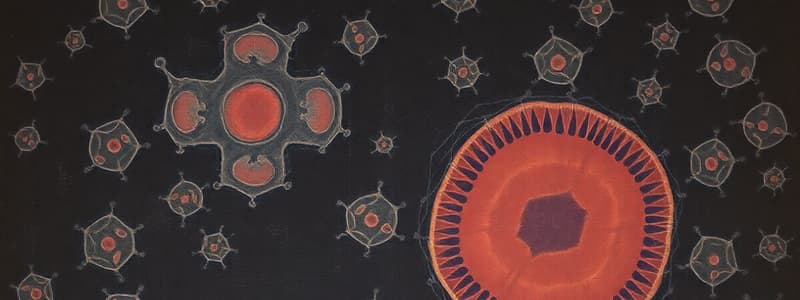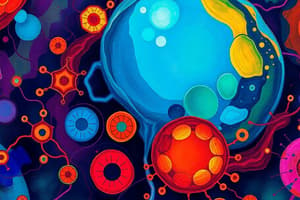Podcast
Questions and Answers
Which structure is responsible for propulsion in bacterial cells?
Which structure is responsible for propulsion in bacterial cells?
- Flagella (correct)
- Ribosomes
- Capsule
- Nucleoid
What is the function of the capsule in bacterial cells?
What is the function of the capsule in bacterial cells?
- Provides rigidity to the cell
- Acts as a sticky coating (correct)
- Helps in protein synthesis
- Stores genetic information
Which organelle is unique to plant cells and is essential for photosynthesis?
Which organelle is unique to plant cells and is essential for photosynthesis?
- Chloroplasts (correct)
- Lysosomes
- Mitochondria
- Ribosomes
What distinguishes the cytoplasm of eukaryotic cells from that of prokaryotic cells?
What distinguishes the cytoplasm of eukaryotic cells from that of prokaryotic cells?
Which structure is essential for the attachment of bacteria to surfaces?
Which structure is essential for the attachment of bacteria to surfaces?
What role do lysosomes play in the immune system?
What role do lysosomes play in the immune system?
What happens to lysosomes in lysosomal storage diseases?
What happens to lysosomes in lysosomal storage diseases?
How do lysosomes contribute to embryonic development?
How do lysosomes contribute to embryonic development?
What is a consequence of Tay-Sachs disease?
What is a consequence of Tay-Sachs disease?
Which of the following is NOT a function of lysosomes?
Which of the following is NOT a function of lysosomes?
What is the composition of a vacuole?
What is the composition of a vacuole?
Which of the following best describes the consequence of missing lysosomal enzymes?
Which of the following best describes the consequence of missing lysosomal enzymes?
What small molecules leave the lysosome to nourish the cell?
What small molecules leave the lysosome to nourish the cell?
What distinguishes single-celled organisms from multicelled organisms?
What distinguishes single-celled organisms from multicelled organisms?
What is the approximate size range for most cells?
What is the approximate size range for most cells?
Which of the following measurements is equivalent to 1 millimeter?
Which of the following measurements is equivalent to 1 millimeter?
Which of these is NOT included in the classification of organisms presented?
Which of these is NOT included in the classification of organisms presented?
What is the main function of the nuclear pores?
What is the main function of the nuclear pores?
What is the size of most bacteria compared to eukaryotic cells?
What is the size of most bacteria compared to eukaryotic cells?
What function does the nucleus primarily serve in a cell?
What function does the nucleus primarily serve in a cell?
What are chromatin fibers composed of?
What are chromatin fibers composed of?
Where are the components of ribosomes produced?
Where are the components of ribosomes produced?
What are ribosomes primarily responsible for in a cell?
What are ribosomes primarily responsible for in a cell?
What distinguishes ribosomes attached to the endoplasmic reticulum from those suspended in the cytosol?
What distinguishes ribosomes attached to the endoplasmic reticulum from those suspended in the cytosol?
How do new living cells typically arise?
How do new living cells typically arise?
What structure within the nucleus is responsible for ribosome production?
What structure within the nucleus is responsible for ribosome production?
Once produced in the nucleolus, where do the ribosomal components travel next?
Once produced in the nucleolus, where do the ribosomal components travel next?
What is the role of ribosomes in cellular processes?
What is the role of ribosomes in cellular processes?
What is the relationship between chromatin and chromosomes?
What is the relationship between chromatin and chromosomes?
What role does the cytoskeleton play in maintaining the position of the nucleus?
What role does the cytoskeleton play in maintaining the position of the nucleus?
How do microtubules assist in cellular movement during cell division?
How do microtubules assist in cellular movement during cell division?
What process allows the cytoskeleton to provide rigidity in new cell areas?
What process allows the cytoskeleton to provide rigidity in new cell areas?
What is the primary method of movement for eukaryotic flagella?
What is the primary method of movement for eukaryotic flagella?
In what way do cilia differ from flagella?
In what way do cilia differ from flagella?
What type of movement do cilia perform?
What type of movement do cilia perform?
How does the dynamic nature of the cytoskeleton contribute to white blood cells?
How does the dynamic nature of the cytoskeleton contribute to white blood cells?
What role do microtubules play in the movement of lysosomes?
What role do microtubules play in the movement of lysosomes?
Flashcards are hidden until you start studying
Study Notes
The Microscopic World of Cells
- Organisms can be single-celled, like most prokaryotes (e.g., bacteria) and protists, or multicellular, like plants, animals, and most fungi.
- The human body is composed of trillions of cells, each with specialized functions.
Sizes of Cells
- Most cells are between 1 and 100 micrometers (µm) in diameter, visible only with a microscope.
- The size and shape of cells are related to function.
Cell Types
- Prokaryotic cells: Smaller and simpler than eukaryotic cells; lack a nucleus and other membrane-bound organelles. Examples: bacteria and archaea
- Eukaryotic cells: Larger and more complex than prokaryotic cells; contain a nucleus and other membrane-bound organelles. Examples: plants, animals, fungi, and protists
Organelles
- Nucleus: The cell's control center, containing DNA in the form of chromosomes.
- Contains nucleolus, the site of ribosome synthesis
- Endoplasmic reticulum (ER): Network of internal membranes involved in protein synthesis (rough ER) and lipid synthesis (smooth ER).
- Golgi apparatus: Processes and packages proteins and lipids for secretion or delivery to other organelles.
- Lysosomes: Contain digestive enzymes that break down waste, worn-out organelles, and engulfed materials.
- Vacuoles: Storage compartments for water, nutrients, and waste. Plant cells often have a large central vacuole.
- Mitochondria: Powerhouse of the cell; responsible for cellular respiration, producing ATP (energy).
- Chloroplasts: Found in plant cells; site of photosynthesis.
- Cytoskeleton: Network of fibers that provides structural support, aids in cell movement, and anchors organelles.
- Microtubules: Long, hollow tubes important for cell shape, movement of organelles, and chromosome separation during cell division
- Microfilaments: Solid rods that help with cell shape, muscle contraction, and cytoplasmic streaming.
- Intermediate filaments: Fibrous proteins that provide structural support and anchor organelles.
Cilia and Flagella
- Cilia: Short, hair-like projections that beat in coordinated waves, moving fluids or propelling cells.
- Flagella: Long, whip-like projections that propel cells in a wave-like motion.
- Both cilia and flagella are composed of microtubules.
- Examples: Cilia in the human trachea move mucus, flagella propel sperm cells.
Other Key Points
- The region between the nucleus and the plasma membrane is called the cytoplasm, which contains the cytosol (fluid) and various organelles.
- Ribosomes are responsible for protein synthesis. Some ribosomes are free in the cytosol, while others are attached to the ER.
- Lysosomes are crucial for cell health. Deficiencies in lysosomal enzymes can cause lysosomal storage diseases, leading to accumulation of undigested substances and cellular dysfunction.
- The cytoskeleton can be quickly dismantled and reassembled, allowing for changes in cell shape and movement.
Studying That Suits You
Use AI to generate personalized quizzes and flashcards to suit your learning preferences.




